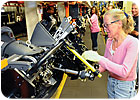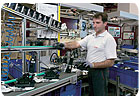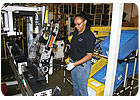According to most forecasts, 2009 is shaping up to be one of the most difficult years that manufacturers have faced in the last seven decades. To survive and thrive in this challenging economy, engineers must renew their efforts to reduce production costs, increase productivity, shorten time to market and improve product quality. Here are some practical tips and suggestions from leading experts.

According to most forecasts, 2009 is shaping up to be one of the most difficult years that manufacturers have faced in the last seven decades. To survive and thrive in this challenging economy, engineers must renew their efforts to reduce production costs, increase productivity, shorten time to market and improve product quality.
The downturn in the economy hit manufacturers hard and fast, like a summer squall on Lake Michigan. For instance, consider the case of Caterpillar Inc. (Peoria, IL), which was flying high just a few months ago. In 2008, the company experienced its sixth consecutive year of record sales and revenues.
“Through the first three quarters, we experienced booming demand . . .,” explains Jim Owens, Cat’s chairman and CEO. “Delivery times for many products were extended, and we were focused on increasing production and expediting shipments to meet customer needs. Then we were whipsawed in the fourth quarter as key industries were hit by a rapidly deteriorating global economy . . . .”
Other people use less-colorful words than “whipsawed” to label what’s been happening lately. No matter what language you choose to describe current business conditions, it all translates into the same sobering message: We’re in the midst of a severe recession. Even manufacturers that have relentlessly practiced lean principles or Six Sigma for years can’t control some of the once-in-a-century issues that are rocking the economy.
“Everything has changed,” says Kevin Duggan, principal of Duggan Associates and founder of the Institute for Operational Excellence (North Kingstown, RI). “The business climate that we once knew is gone, and high uncertainty surrounds us. The challenges are different, and our typical cost-cutting measures don’t come close to matching the drop in customer demand.” To survive and thrive in today’s chaotic and volatile market, Duggan believes manufacturers have to use a football strategy: First establish a good defense and then turn up the offense.
“Just as families are reining in spending to stay afloat, manufacturers, too, are cutting back on everything but the bare essentials,” adds Don Penkala, president of Granite Bay Global (Granite Bay, CA). “While many will be forced to make huge cost cuts, there is an opportunity for manufacturers to spend time evaluating the effectiveness of certain programs and other cost drivers.
“[This is a good time to] eliminate those that aren’t producing results or aren’t producing them fast enough,” adds Penkala. “Obviously, in a severe cash and credit crunch, many discretionary activities will have to be postponed. But, smart managers are being more critical of spending and demanding quicker returns, rather than gutting vital programs and activities.”
Penkala and other manufacturing consultants believe that tough times offer engineers a great opportunity to play hero in their plants. By tuning up production processes during a slowdown, your assembly lines will be ready to hum once business conditions start to improve, which some experts predict will start to happen later this year.
No matter what you do, be sure to engage in active dialogue with your assembly team. “During these tough times, it is important to maintain goodwill and morale, and try to reduce the stress on the workforce,” explains Penkala. “It’s always best to be open and honest with employees and explain the business situation in detail and why specific cost cuts are needed.
“Employees understand that in tough economic times, only those activities and programs that conserve resources and capital will be permitted,” notes Penkala. “There is also an opportunity to build a sense of teamwork and commitment by working together-leaders and operators, maybe for the first time-to find innovative ways to cut costs and generate revenues.”
“Mental attitudes about the current economic situation undermine morale and productivity,” warns Dave Gardner, president of Gardner & Associates Consulting (Reno, NV). “Make sure your team understands the current economic situation is a normal, cyclical challenge that, while more extreme than many economic downturns, creates opportunities. Focus on making the company stronger and more competitive during this time.”
If your company has not adopted continuous improvement strategies, this might be a good time to start. Richard Ligus, president of the Rockford Consulting Group (Rockford, IL), believes it’s never too late to implement lean principles. “[Any company should do] three things in a recession to reduce production costs, increase productivity, and reduce lead times: Lean training, 5S and kaizen events,” he points out.
“Lean training can be conducted when business activity is down, and resources are available,” explains Ligus. “The 5Ss are necessary to prepare the assembly floor for further lean manufacturing initiatives, and are a good first step in a lean implementation. Kaizen events are a way to get workers involved in the change process, and to pick the low-hanging fruit.”
Ligus says one of his clients, a company involved in electromechanical assembly, followed that strategy. The manufacturer was able to achieve a 50 percent decrease in throughput time and direct labor, enabling a 100 percent capacity increase in each work area affected. “The decrease in throughput time enabled them to deliver products in half the lead time previously, with half the direct labor hours,” claims Ligus. “The capacity increase using the same amount of direct labor spread overhead over twice the number of products, resulting in a significant cost reduction.”
“Learning about lean principles and applying the right strategy to your unique operation remains one of the best investments manufacturers can make,” adds Penkala. He has tracked lean activity and discovered that, with the right implementation, manufacturers can achieve anywhere from 260 percent to 1,500 percent return on investment. “With the low up-front costs and the possibility of self-funding lean programs, they remain an even better bet in the current economy,” he proclaims.

Use Down Time Productively
Today, many assembly lines are running much slower than in the past. As a result, there’s a lot more idle time on plant floors. But, manufacturing engineers should take advantage of that situation.
Gardner says it’s a great opportunity to focus on the improvement projects you didn’t have time to tackle during busier times. “Sit down with your team members, either in groups or individually, and brainstorm ideas to increase productivity,” he suggests. “Capture and prioritize the list in terms of impact. Put teams in place to work the high-impact issues. However, initiatives need a name and a date for reporting back.”
Don Ewaldz, a veteran manufacturing industry consultant based in Rockford, IL, urges plant managers and engineers to “get tough on idle time.” He says any plant can’t afford to have people sitting around, whether the economy is strong or weak.
Manufacturers in many industries are currently running assembly lines with 5 percent to 10 percent more capacity than at this time last year, which can result in an extra hour or two a day. “All of a sudden, they have extra time in their production process,” notes Jamie Flinchbaugh, partner in the Lean Learning Center (Novi, MI). “A lot of operators aren’t running at the same pace they were six months ago. Rather than loafing around, they should do something strategically with the extra time on their hands.
“Don’t just fill up that time with idle tasks; use it to get your employees thinking more productively,” warns Flinchbaugh. “Encourage them to spend time breaking down your entire assembly process or experimenting with the way that your products are designed for assembly.”
While things are slow, it also may be a great time to rebalance your line. As products and processes change over extended periods of time, the original balance may no longer be valid.
The traditional method of line balancing uses inherent balance. However, this is often difficult to achieve and, even when done well, results in “as much as a 20 percent balance loss because of cycle-to-cycle variation, differences in worker ability, and changes in product or option mix,” claims Quarterman Lee, president of Strategos Inc. (Kansas City, MO). “In addition, there are other ways to achieve balance, such as floating balance and queuing between stations.”
While traditional assembly lines work well for high-volume, low-mix production, many lines must now produce a variety of models or variations. If the line is set up, scheduled and operated for one model and then changed over for the next, it forces long changeover times and large batches.
“This in turn can produce excessive finished goods inventory and scheduling problems,” Lee points out. “It also can result in surges and demand variation for upstream suppliers or fabrication areas. Mixed-model production allows a variety of models on the same line so that the daily or weekly production rate for all models is essentially constant.”
Lee says manufacturing engineers should also consider creating more assembly cells. “Smaller, more focused lines or multiple assembly workcells often provide better results [than traditional assembly lines],” he explains. “Cells and smaller lines also reduce demand variation and reduce both finished goods and work in process inventory.”
Richard Schonberger, president of Schonberger & Associates (Bellevue, WA), believes that many manufacturers cling to an outmoded, high-cost, slow-reaction mode in which many product items compete for time on too few, too long assembly lines. He also suggests rebalancing linear workflow with several short, compact cells.
“If three assembly lines become 12 small cells, four times more product and package types may be assembled at a time,” Schonberger points out. “The impacts include quicker market response, less inventory, less reliance on [stale] forecasts, and faster reaction to quality or other problems.
“Four times more assembly units will require investment in more assembly equipment, but not nearly four times as much,” adds Schonberger. “Cells dedicated to higher volume items would receive the lion’s share of investment for some level of automation. The majority of items are likely to be low-volume, warranting a simple, manual treatment with low-cost equipment, minimal engineering design, minimal maintenance, and opportunities for a degree of self-management by cell-team members.”

Maintenance Matters
When the economy is tough, manufacturers typically focus more on preventative maintenance efforts. “In an environment where capital spending may be out of the question, preservation of existing equipment is essential,” claims Michael Perreault, president of Excel Performance Inc. (Hugo MN). “It is [important] that your line keep functioning with minimum capital expenditure.
By investing in the health of your system, you can maximize net production output by minimizing downtime. For instance, Perreault says a technician can easily add a diagnostic element to a production machine that can indicate possible deterioration. By analyzing the speed of various functions, variation in speed can be a symptom of a possible mechanical failure in the future.
“Generally, devices and mechanisms do not go from excellent working condition to malfunction,” Perreault points out. “They usually wear out and deteriorate, which can be noted by speed changes. If the timing of the control device changes parameters, a notification can be activated, giving maintenance people time to address the issue prior to it becoming a problem.”
This may also be a good time to consider outsourcing equipment maintenance. “How many maintenance guys do you really need?” asks Ewaldz. He says many leading manufacturers either subcontract maintenance or are thinking about doing it. In fact, Ewaldz has conducted half a dozen studies of firms outsourcing maintenance tasks over the past couple of years. In each case, the companies were able to cut costs.
“The argument against going outside for maintenance usually includes such things as, ‘It would cause more downtime waiting for the maintenance guys’ or ‘Our stuff is so technically advanced, no one else could ever fix it,’” notes Ewaldz. “However, in one instance [where maintenance was outsourced], it provided even better results than we had forecasted.”
Manufacturers should also tighten their inventories and strengthen their supply chains. Flinchbaugh says this is a great time to “get better connected to your customers.” For instance, one way to better understand customer orders is by using tools such as demand segmentation or PFEP (plan for every part).
According to Joe Panebianco, director of the LeanSigma Institute at TBM Consulting Group Inc. (Durham, NC), demand segmentation is not understood well and, as a result, is not used as much as it should be. “It can determine whether products should be made to inventory, such as items constantly in demand, or made to order,” he points out. “Demand segmentation can help you determine how to set up your manufacturing operations to drive efficiency and customer service. It can significantly reduce inventory and free up valuable working capital.”
Another important inventory management tool is PFEP, which is a database that fosters accurate and controlled inventory reduction. It is the foundation for the continuous improvement of a plant’s material-handling system, says Rick Harris, president of Harris Lean Systems Inc. (Murrells Inlet, SC). “When applied correctly, you can achieve a 50 percent reduction in inventory and take a lot of cost out of your production process.” Harris recommends applying PFEP to the top 20 percent of part numbers that make up 80 percent of your volume.
Manufacturers should also use the slowdown in business activity to take a careful look their supply base. Some experts suggest assessing key suppliers to determine which ones are willing to work to mutually lower the cost of procurement.
“This includes material pricing, as well as the costs of ordering, receiving, quality and inspection,” says Penkala. “This is not an excuse to ‘bully’ suppliers into accepting price concessions or creating adversarial competition on unit pricing. It is an opportunity for both suppliers and customers to work more collaboratively and better understand each other’s businesses to drive down costs in both organizations.”
Penkala also recommends evaluating the true cost of offshore manufacturing. “More and more companies are reporting that the hidden costs of offshoring, especially those associated with transportation, inventory, late shipments and long lead times, can be a bigger burden than running a lean facility here in the U.S.,” he explains.
While reviewing inventory issues, manufacturing engineers should also look for opportunities for curtain operations. According Kirk Paluska, a consultant with the Lean Transformations Group (Hartford, CT), that term refers to the “Wizard of Oz.”
“Curtain operation are used relative to a cell or line where you have continuous flow,” explains Paluska. “Flow means you have dedicated some personnel and machines to a particular product family, and you have arranged the equipment in the order of process sequence.”
Paluska says true curtain operations share several characteristics:
- They fall somewhere in the process sequence.
- They involve a shared capital resource that cannot be located in a cell. A shared resource supports multiple product families.
- They are “managed” in the cell with inventory buffers, including an outgoing queue and an incoming queue.
- They have a standard amount of inventory in the loop. This standard inventory remains fixed at all times and is based on the Little’s Law formula (inventory = lead-time/takt).
- “The outgoing and incoming queues are all that appear to the cell,” says Paluska. “Operators in the cell always follow the rule one-in, one-out. When they place a part into the outgoing queue, they must pick one up from the incoming queue to keep the buffer quantity constant.
“The buffer inventory creates virtual continuous flow around the curtain operation,” adds Paluska. “It’s as if there is a curtain behind these outgoing and incoming queues, where a hand (in reality, the material handler) reaches through the curtain, picking up parts to be processed by the shared resource, and another hand returns them to the incoming queue.”
For the one-in, one-out rule to work, Paluska says the same worker should put parts in and take parts out. “These queues are not in-process queues or in-process kanbans between workers,” he points out. “Curtain queues are fixed buffers. In-process queues or kanbans are variable buffers for in-cell hand-offs.”A
To find more tips on how to improve your line in tough times, search for these articles at www.assemblymag.com:
-
How to Keep Operators Productive in a Downturn.
-
Offense vs. Defense.
